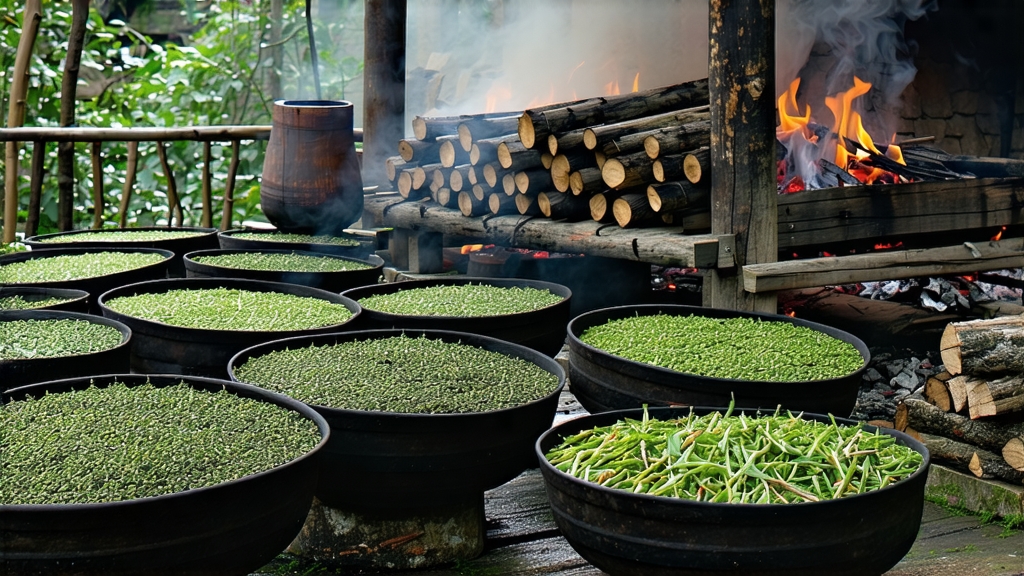
When European tea clippers first rounded the Cape of Good Hope in the late seventeenth century, the cargo that most excited London merchants was not silks or porcelains but small, glossy-leafed chests from the Wuyi Mountains labeled “Bohea Souchong.” That fragrance—at once resinous, malty, and faintly citrus—was the West’s inaugural encounter with what we now call black tea. The Chinese had been drinking it for more than two centuries already, and they still use its original name: Zheng Shan Xiao Zhong, literally “Original Mountain Small Leaf,” today celebrated globally as Lapsang Souchong.
History: From Ming-Era Mist to Victorian Cups
Legend places the birth of Lapsang Souchong in 1567, when a Wuyi tea troop was forced to hastily dry freshly picked leaves over pine fires to meet an advancing Qing army. Whether apocryphal or not, the technique survived and thrived. By the early 1600s, tea merchants in Xingcun village were exporting this smoked black tea through the port of Quanzhou to Dutch intermediaries. The British East India Company popularized it under the anglicized “Lapsang,” a corruption of “Lapu Mountain,” while “Souchong” refers to the fourth and fifth leaves that give the tea its broad, robust character. When cheaper, unsmoked black teas from India and Ceylon flooded Europe in the nineteenth century, Lapsang Souchong retreated into connoisseur circles, only to re-emerge in the twenty-first century as the flagship of China’s “new wave” artisanal blacks.
Terroir: The National Park in a Cup
Authentic Zheng Shan Xiao Zhong can only be produced inside the 60 km² core of the Wuyi National Scenic Reserve, a UNESCO dual heritage site where granite cliffs, mineral-rich red soils, and a subtropical monsoon climate create a diurnal temperature swing of 10 °C. The indigenous cultivar is Xiao Ye Zhong (“small leaf stock”), a slow-growing shrub that develops thick cell walls and a high ratio of polyphenols to amino acids—ideal precursors for both oxidation and smoke absorption. Surrounding forests of Masson pine (Pinus massoniana) provide the resinous fuel that imparts the tea’s signature terpene note, while mountain mists filter sunlight, coaxing the leaves to synthesize more linalool and geraniol, the same floral volatiles found in oolong.
Craft: The Eight-Stage Pine-Smoke Ballet
- Plucking: Only one bud with two or three leaves is picked between Qingming and Grain Rain, when spring oils peak.
- Withering: Leaves are laid on bamboo trays inside wooden sheds heated indirectly by pine embers (38–42 °C, 70 % RH) for 8–10 hours; moisture drops to 60 %.
- Rolling: A 45-minute gentle roll breaks 70 % of cell walls without fragmenting the leaf, releasing catechins and polyphenol oxidase.
- Oxidation: The rolled leaf is piled in cedar-lined troughs 25 cm deep for 3–4 hours at 24 °C. Oxygen converts catechins into theaflavins (golden brightness) and thearubigins (brisk body).
- Primary Smoke-Dry: The semi-oxidized leaf is spread 3 cm thick on wire mesh above a pinewood fire (60 °C) for 20 minutes; surface moisture plummets to 20 %.
- Re-rolling & Second Oxidation: A lighter 15-minute roll re-exposes juices; 45 minutes of oxidation deepens color.
- Final Smoke-Drying: The most artisanal step. Fresh pinewood is lit, allowed to flame for 30 seconds, then smothered to generate cool, aromatic smoke (45–50 °C). The tea is dried in this environment for 6–8 hours until moisture reaches 4–5 %. Masters judge readiness by sound: a squeezed leaf should crunch yet spring back.
- Rest & Finish: The tea is rested in unglazed clay jars for 30 days to homogenize smoke and floral notes, then charcoal-tasted to remove any off-odors.
Grades: From Campfire to Cognac
Traditional Lapsang Souchong is graded by leaf size and smoke